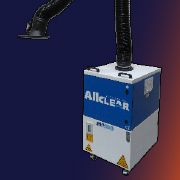Gasless ('MIG') Welding of thin section steel - should I use 0.8mm or 0.9mm wire?
Here's why 0.9mm, rather than 0.8mm, may actually be your best choice for thinner materials
When it comes to 'MIG' welding thinner sections with gasless welding wire - for example 1.6mm sheet or RHS/tube - many welders logically assume that when it comes to choice of wire size, 0.8mm wire will be better than 0.9mm.
Strange as it may seem, this is not necessarily the case. Here's why;
0.8mm Gasless Wire does not directly compare to 0.8mm Solid (gas) MIG Wire:
If you are accustomed to using 0.8mm solid (gas) MIG wire for welding thinner gauge steel, then you might naturally assume that 0.8mm gasless wire is also the best option.
However, 0.8mm Gasless Wire does not directly compare to 0.8mm Solid (gas) Wire. This is because gasless wires are flux-cored, meaning they have a hollow core filled with flux - therefore a gasless wire will have less filler metal per KG than a solid wire of the same size.
For this reason alone, 0.9mm gasless wire will often do the same job as 0.8mm solid wire.... depending on the quality of the wire.
The right 0.9mm Gasless Wire will easily weld thin materials
If you've tried different brands of gasless wire, you'll agree that there is often a significant difference from one to another. This is because the formulation of the flux has a big impact on how the wire performs... and every brand of wire has it's own formula.
A top performing 0.9mm wire, like the Weldclass Platinum GL-11® will be much more "tolerant" to variations in material thicknesses and will easily weld thinner materials.
In fact, Platinum GL-11® is arguably Australia's number 1 gasless wire when it comes to user appeal. The formula of this wire has been perfected over many years to offer exceptional performance... including ability to weld a wide variety of thicknesses using 0.9mm. GL-11® is also tolerant to variations in parameters, which means that you won't have to constantly play with the settings on your welder to make the wire run like it should.
Formulation (of wire & flux)
This one is difficult to explain in a few words... but we'll do our best to make sense!
The formula for 0.8mm gasless wire is not the same as 0.9mm (or shouldn't be). This is because different size wires have different arc characteristics, different operating parameters, etc - and changes need to be made to the formula to accommodate this.
Also, being physically smaller (with less "room" to fit both wire & flux), it is even more difficult to achieve a successful formula for 0.8mm, than it is for 0.9mm.
Our Platinum GL-11® in 0.8mm is also a top-performing wire... but we still sell over 10 times more 0.9mm than we do 0.8mm. Why? because Platinum GL-11® in 0.9mm is so versatile & can be used on both thinner & thicker materials.
Cost benefits when using 0.9mm
Using 0.9mm rather than 0.8mm can save you money too. Per KG, 0.8mm is always more costly than 0.9mm - this is because; a) per KG, smaller diameter wires cost more to manufacture, and b) 0.9mm wire is more popular and manufactured in much larger volumes which helps to reduce the cost.
So when should I use 0.8mm?
We're not saying that 0.8mm gasless wire doesn't have its place. If you are constantly welding very thin materials (say 1.0mm for example), then 0.8mm could make sense.
And/or if you have a smaller MIG welder with maximum capacity of say 130-150 Amps, then 0.8mm wire may be more suitable to the output range of your machine.
But all the same, we often find that operators who previously thought they had to use 0.8mm are pleasantly suprised to find that our Platinum GL-11® in 0.9mm does everything their previous 0.8mm wire did and more.
Conclusion
- Try 0.9mm, you may be pleasantly suprised with results on thinner materials!
- Don't settle for a sub-standard wire - use a premium gasless wire such as Platinum GL-11®
This blog is intended to help with: What is the best size gasless wire to use on thin steel or gal (galvanised) steel? // What size gasless wire should i use?
While all care has been taken, Weldclass accepts no responsibility for any inaccuracies, errors or omissions in this information or links and attachments. Any comments, suggestions & recommendations are of a general nature only and may not apply to particular applications. It is the sole responsibility of the user and/or operator to select the appropriate product for their intended purpose and to ensure that the product selected is capable of performing correctly and safely in the intended application. E.&O.E.
-
Hi Cedrick, thanks for reaching out. It is not advisable to use the incorrect size roller for the wire. It some cases you can get away with it, but the end results may vary depending on the rest of the set up.Date: 08-03-2022Weldclass Weldclass -
Can I use the 0.9mm flux core wire on a .08mm or 1.0mm roller also? Or is it not advisable.Date: 07-03-2022Cedrick B Titus -
I find your Instructions and Advice very helpful. Thank you & gratefulDate: 08-06-2020Eric Mapes nil -
Thanks, great post just bought some. Time to buy a welder to go with my wire :)Date: 28-05-2020BZ -
Hi, Randomly google searching and found the above info - Thanks. Perhaps six years ago I bought 5x 5kg rolls of 0.8mm gasless, and it has taken me this long to get through it all doing odd jobs over the years. Only last month I bought two rolls of 0.9mm, different brand - and its like chalk and cheese. This 0.9mm stuff feeds and works so much nicer --- there is no constant fighting that it is now actually enjoyable; Why didn't I do it sooner! I had no idea there could be so much difference. And then I assume that GL-11 would be a whole new level of experience again. Cheers.Date: 16-05-2020Dave -
John, you can find wire for this application (gas & gasless) under the “Consumables/Hardfacing Wire” product section of this website. This includes comparison info with pros & cons of gas vs gasless options; https://www.weldclass.com.au/category/189-hardfacing-wireDate: 08-05-2020Weldclass Weldclass -
Hi, what gas or gasless wire do you recommend for Hardfacing of Agricultural equipment, plough points, bucket edges, earth digging etc using a MIG welder. Regards John BendellDate: 08-05-2020John -
Hello Steve, If the drive roller and the liner in the torch is set up for 0.8mm, then we would not recommend using 0.9mm without changing these parts. If you have a standard V-groove drive roller for 0.9mm, you could try this. Whilst knurled rollers are ideal for gasless wire, we have often found that V-groove rollers work fine for 0.9mm gasless providing that the torch is not longer than 4m (ideally 3m). The liner inside the torch is normally colour coded (plastic cover over the steel liner); Blue = suitable for max 0.8mm wire. Red = suitable for 0.9mm wire. A liner is easy to replace and not very costly. Hope this helps!Date: 30-01-2018Weldclass -
I just read your report suggesting using a 0.9 instead of a 0.8 flux core Platinum 1 wire. While I understand this can you advise if this can be used in a machine that is set up for 0.8 flux core. Eg roller etc. The machine is a Uni Mig Viper 150.Date: 30-01-2018Stephen -
Thank you for your comment Brett. GL-11 is classified as E71T-11, which in broad terms is a general purpose gasless wire suitable for multi-pass welding. Hobart Fabshield 21B is also classified as E71T-11. The other wires you mention are different classifications, intended for different applications. Hobart Fabshield XLR-8 is a high strength (lower hydrogen) gasless wire for medium to heavy fabrication, classified as E71T-8 & is not available in sizes less than 1.6mm. Cigweld 3XP range are flux-cored wires used with gas (not gasless). If your application is welding thinner materials with gasless wire, then GL-11 is your best option. Hope this helps!Date: 15-11-2017Weldclass -
Thank you for all the straight talking info. I am soon to try your GL 11 .9. Can i asume that it is similar in hydrogen content to cigweld 3xp or hobart fabshieldb21 H8Date: 14-11-2017Brent sheehan B&B Sheehan





